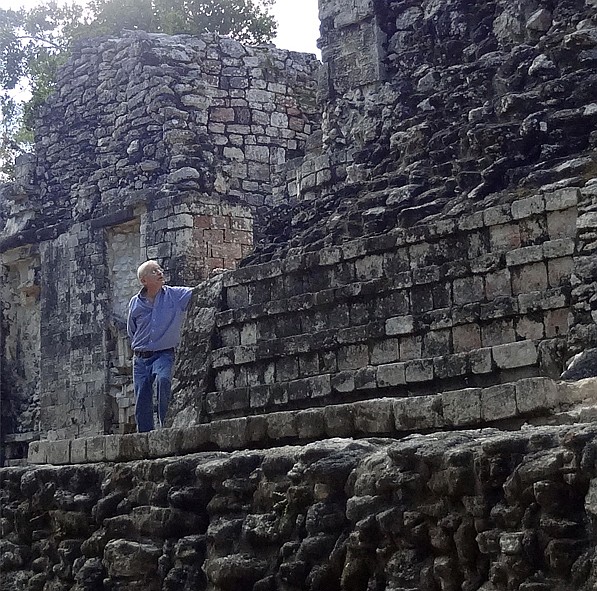- April 4, 2025
-
-
Loading

Carl Abbott is a thoroughly modern architect, a working practitioner of the Sarasota School of Architecture. He’s not a Luddite or the architectural equivalent of Indiana Jones. Abbott looks to architecture’s future. But he also sees surprising echoes of that future in the past.
Ancient architecture fascinates him — Maya structures most of all.
We speak about it at his north Sarasota offices, a low-slung complex on a sprawling tract of land off Whitaker Bayou. It looks like a jungle. It’s easy to imagine a Maya temple rising up in the distance.
I tell him that. Abbott smiles and says, “Sure.” He politely adds that, outside of the fakery of Disney World, a Maya structure wouldn’t really work in Florida. They exist in context. Specific buildings, designed for specific sites.
Well, by definition every building relates to its site. But some do it better than others. Frank Lloyd Wright was the modern architect who did it best. The relationship of structure to site was the foundation of his organic architecture. Abbott follows in Wright’s footsteps with his insistence that every building be “informed by the land.”
A very modern principle. And an ancient one, as Abbott discovered in 1976.
That’s when he and his two young sons traveled to the Yucatan to experience the architectural legacy of the Maya.
“I thought they’d be excited,” he says. “But I was more excited than they were. I could see that the Maya buildings were tied to the sun, to the stars, to the form of the land itself. There was a whole spatial vocabulary and set of connections.”
Abbott had detected a Mayan resonance with the principles of modernist architecture, and his own work. “I realized that what the Maya were doing was very close to what I was doing. Of course, they did it first, thousands of years ago.”
In the years that followed, Abbott explored the Mayan connection.
It started with research and occasional trips. About a decade ago, those trips became more frequent. The architect teamed up with archeologists and anthropologists. This dream team of Ph.D.s includes New College professor Tony Andrews; Millsaps professor George Bey; Davidson College professor Bill Ringle; Tomás Negrón, an archaeological researcher at Mexico’s National Institute of Archaeology and History; and Patricia Plunket, a professor at the University of the Americas (and Sarasota writer Bob Plunket’s sister).
They’re the top specialists in their fields. And far more likely to contribute to National Geographic than Architectural Digest. But Abbott has an architect’s eye. And he saw things they didn’t.
“I’d point something out,” he says. “The initial response was, ‘Abbott, you’re crazy.’ But they finally realized I was onto something.”
The architect has shared his insights at the Maya at the Playa international conference, and at slideshow lectures around Florida and the nation. He shared his insights with me—in a highly simplified form.
Here’s an overview of the Mayan/modernist connection:
Relate to the land
Before designing for a site, Abbott always goes there in person. He’ll rent a bucket crane to see what it looks like from different elevations. Work out the permutations of sun, wind and view for a structure that doesn’t exist yet. It’s standard operating procedure. Or it should be.
Abbott lists examples of Western architects and city planners imposing Cartesian order whether the land likes it or not—and the disastrous results that followed. The Maya were the opposite. “Each Maya structure was different,” he says. “They specifically designed each structure for the contours and orientations of its site. The land always came first. The Maya had organizing principles, but they adapted their sense of order, never imposed it.”
Sun and shadow
According to Abbott, any decent architect thinks about a building’s relationship to the sun. A good architect thinks about that relationship over time. His latest work in progress is one example — a beachfront house on Casey Key. The structure has two wings, each oriented to tap into the sun’s heat in the winter and offer shade in the summer. The view sides face the water, naturally. The building’s largest overhang directly faces the sun during the summer solstice, he says. “The shadow effect will be very dramatic.”
Abbott adds that it pales in comparison to what the Maya did at Chichen Itza, where every equinox, the stairs cast an undulating shadow resembling a snake as a tribute to Kukulkan, the serpent God.
“The level of engineering and astronomical awareness is astonishing,” he says.
Secrets and surprises
Abbott lists other parallels between his work and the Maya’s surprisingly high-tech techniques. His stairway at the Dolphin house on Siesta Key is wider at the bottom than the top, creating the illusion of greater height. It’s called forced perspective, and the Maya beat him to it. Another technique? Rotating an element off a building’s dominant axis to create a sense of surprise. Abbott often skews floors at different angles from the building’s main orientation. The Maya did it with stairways and walls.
What’s going on, exactly?
It’s probably the most modern technique of all ... mind games. “Psychology,” says Abbott. He says Maya buildings play with one’s perception. “Essentially, the structure creates a set of expectations in your mind, and then it does the unexpected.”
It’s something Abbott does in his own work. It takes one to know one, as they say.
“A static building is dead,” he says. “A building that surprises and engages you is alive. That’s what Wright, myself and others try to do. That’s what the Maya did, and it flowed out of their animist belief system. Their buildings weren’t dead stones; they were alive. That’s what they thought, and, in a sense, they were right. Centuries after they were built, the Maya structures still have life.”